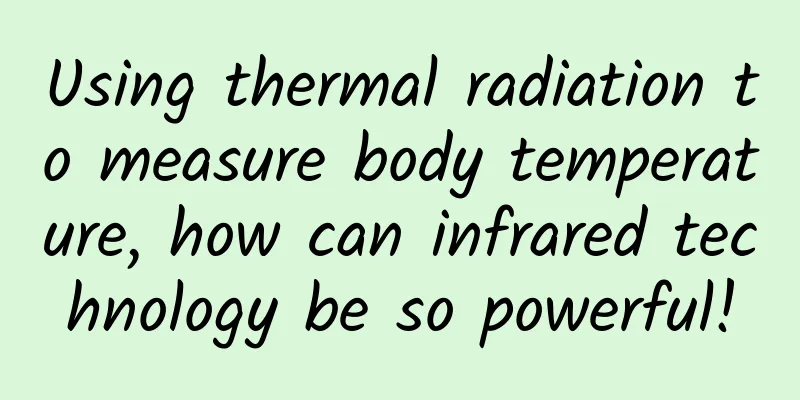Using thermal radiation to measure body temperature, how can infrared technology be so powerful!

|
Since the outbreak of the new coronavirus pandemic in 2020, everyone must have become very familiar with various temperature measuring devices, big, small, round, flat... Perhaps the sentence you hear most often now is "Come, let's take your temperature." Source: veer gallery Unlike the mercury thermometers that were clipped under the armpits in the past, the current method of measuring body temperature seems to be more "advanced". As long as you walk in front of it, it can tell you your body temperature. Are you curious about how they get our body temperature? Let me give you a brief scientific introduction. First of all, we need to understand a concept, that is, any object with a temperature exceeding 0K (-273.15℃) will emit thermal radiation, also known as electromagnetic waves. The higher the temperature, the stronger the thermal radiation. In other words, as long as there is an object on this earth, it will emit thermal radiation. Infrared temperature measurement is based on this principle. The infrared thermometer obtains the thermal radiation emitted by our human body and then displays our body temperature based on the strength of the thermal radiation. Its specific temperature measurement process is: the infrared thermometer captures the infrared radiation of the measured object through the optical system and sends it to its infrared detector. The detector converts the thermal radiation into a voltage signal, and the voltage signal can be converted into temperature for output after being processed by the readout circuit. From the working principle and working mode of the infrared thermometer, it has outstanding advantages such as fast measurement speed and non-contact. These advantages make the infrared thermometer play a huge role in epidemic prevention and control. Source: veer gallery These advanced temperature measurement methods actually benefit from the development of infrared technology. The application of infrared technology is not limited to measuring temperature. Today we will talk to you about the development and evolution of infrared technology. As early as the 19th century, infrared imaging technology appeared in the public's field of vision. People found that it was more convenient and effective to use infrared detectors to study the infrared radiation characteristics of astronomical bodies. Later, due to the huge application potential of infrared imaging technology in the military, various countries invested a lot of manpower and material resources to vigorously develop infrared technology in the war era. Since then, the development of infrared imaging technology has been in full swing, and infrared imaging, infrared tracking, infrared early warning, infrared countermeasures, infrared guidance and other technologies have been widely used in the military. After 1970, infrared technology gradually transformed from the military field to the civilian field. Various advanced infrared technologies (such as infrared remote sensing, infrared temperature measurement, infrared detection, infrared security, infrared anti-counterfeiting) have been demonstrated in all walks of life. The adoption of these new technologies has improved measurement accuracy, product quality, work efficiency and automation, greatly promoting the prosperity and development of these industries. In recent years, with the development of emerging technologies such as "smart +", the development space of infrared technology has also been further expanded (Figure 3). For example, infrared imaging technology has many applications in the civilian field: • Civil security: security monitoring • Autonomous driving: Night vision assistance • Firefighting: Detection of survivors at fire scene, forest fire detection • Industry: abnormality detection of circuits and mechanical equipment Applications of infrared technology in the civilian field: (a) Night vision (b) Tracking (c) Medical diagnosis (d) Body temperature monitoring (e) Remote sensing (f) Power fault diagnosis (Image source: Reference [1]) Nowadays, the application of infrared technology can be seen everywhere in our lives. This is inseparable from the hard research of generations of scientists. It is technology that brings convenience to our lives. We, the young scientific researchers, should take over the baton from the previous generation, so that the road of science will continue to extend towards a bright future, and attract more like-minded partners to embark on this road and jointly create a more technological tomorrow! Editor: Wang Tingting References [1] Bai Le. Research on infrared image non-uniformity correction method based on adaptive integration time adjustment[D]. University of Chinese Academy of Sciences, 2020. Produced by: Science Popularization China Author: Li Ting (Institute of Optoelectronics, Chinese Academy of Sciences) Producer: China Science Expo |
<<: Exploring the Sun, we did it!
>>: For some basic science, what are the small white dots on the poster of "The Wandering Earth 2"?
Recommend
Analyze how to place information flow ads in the automotive industry from 3 perspectives
"Golden September and Silver October" i...
From the crossover of Confucius Temple IP, how Six Walnuts "transformed" for the second time
It's the college entrance examination season ...
What are some ways to reduce user disgust?
“Advertisements are annoying!” When it comes to a...
How to write promotional ideas, write like this!
Why does my ad not have any traffic even though i...
40th Anniversary of Antarctic Expedition | Traveling through 40 years, looking at the meteorological expedition team members in the Antarctic "treasure hunt game"
This year marks the 40th anniversary of my countr...
Are these “mysterious circles” in the desert really the work of aliens?
In the desert grasslands of Namibia in southern A...
Shared bicycles are so popular that power banks are also joining in the fun. Why are Tencent and Xiaomi investing hundreds of millions but being ridiculed by Wang Sicong?
With the emergence of shared bicycles, the "...
How to write a 99-point event planning proposal?
If you give a campaign plan 100 points, then toda...
When information flow copywriting has been overused, how can you stand out and make users’ eyes light up?
Before we get into the topic, let’s look at a cas...
Temperatures in many places have "plunged", with strong winds of level 9 in some areas! The first cold wave of the Year of the Snake continues to ferment, beware of the "wind chill effect" →
The Central Meteorological Observatory continued ...
Baidu search for the most powerful oCPC advertising secrets!
This article shares with you the "Baidu Sear...
How does a live broadcast pitcher create a live broadcast with a GMV of over 100 million?
Brands focus on products, anchors focus on conten...
Could the "neglected" Venus have once been a habitable planet?
Which planet is the closest to Earth? It is Venus...
How harmful is it to drink sugary drinks for a long time? Experts give the answer. Do you dare to drink it again after reading this?
Do you usually drink milk tea or other beverages?...
A must-read for marketers: 5 senses and abilities you must master!
I have read many marketing books and found that th...









